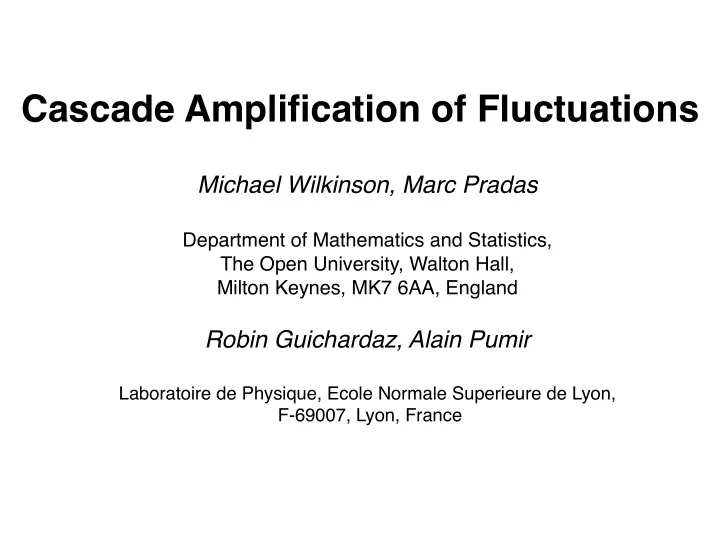

Cascade Amplification of Fluctuations � � Michael Wilkinson, Marc Pradas � � Department of Mathematics and Statistics, � The Open University, Walton Hall, � Milton Keynes, MK7 6AA, England � � Robin Guichardaz, Alain Pumir � � Laboratoire de Physique, Ecole Normale Superieure de Lyon, � F-69007, Lyon, France � � �
An unsolved problem? Anomalous diffusion h x 2 i ⇠ t α , α 6 = 1 is widely observed. It is often ‘explained’ by postulating another power-law in the equation of motion (for example, a waiting-time distribution). � However, fundamental physical laws do not contain non- integer exponents. It is desirable to find more mechanisms where power-laws emerge naturally. This talk describes a new source of non-integer power-laws.
Our investigation Separations of nearby particles in complex flows were investigated, with thermal noise: √ x = v ( x, t ) + ˙ 2 D η ( t ) h η ( t ) η ( t 0 ) i = δ ( t � t 0 ) h η ( t ) i = 0 We consider a case with negative Lyapunov exponent. Without noise, nearby trajectories coalesce. We expect that, with noise, an Ornstein-Uhlenbeck model is applicable. This implies a Gaussian distribution of separations. √ λ < 0 ∆ ˙ x = λ ∆ x + 2 D η ( t ) − | λ | ∆ x 2 ✓ ◆ P ∆ x = C exp 4 D
Small particles in turbulent flows 1.5 Equations of motion for small 1 a 0.5 particles (1-d model): x 0 -0.5 ˙ = 0 200 400 600 800 1000 x v 1.5 1 ˙ = γ [ u ( x, t ) − v ] b v 0.5 x 0 For sufficiently large damping -0.5 0 200 400 600 800 1000 the paths of particles t Z ( t ) = δ ˙ x coalesce: we are interested δ x in this case where the Z t Lyapunov exponent is 1 d t 0 Z ( t 0 ) λ = lim negative: t t !1 0
Effects of noise √ Add Brownian diffusion to ˙ = v + 2 D η ( t ) x the model: ˙ = γ [ u ( x, t ) − v ] v h η ( t ) η ( t 0 ) i = δ ( t � t 0 ) h η ( t ) i = 0 The distribution of separations of particles was found to be non-Gaussian. It has well-defined power-law tails: P ( ∆ x ) ∼ | ∆ x | − (1+ α ) , α > 0
Power-law distribution The probability density of separations is a power-law: the exponent depends upon the damping coefficient: a � x � 0.985 P( � x) P ∆ x ∼ | ∆ x | − (1+ α ) 0.1 � x b 100 � x � 1.34 P( � x) 10 1 0.1 10 � 4 10 � 3 10 � 2 10 � 1 � x
Intermittency Numerical experiments also show that the particle separations are intermittent, with occasional large excursions. 5 0.5 � x 0 4 � 0.5 3 0.5 2 � x x 0 � 0.5 1 0.5 0 � x 0 � 0.5 � 1 0 5000 10000 15000 2500 5000 7500 10000 12500 15000 Time Time
Cascade amplification of noise Linearised equation of motion for particle separations: Z ( t ) = ∂ v √ δ ˙ x = Z ( t ) δ x + 2 D η ( t ) ∂ x ( x ( t ) , t ) The instantaneous Lyapunov exponent is negative most of the time, but has occasional positive excursions, with frequency independent of the particle separation. Scale invariance indicates a logarithmic variable: Y = ln( ∆ x ) P Y ∼ exp( − α Y ) P ∆ x ∼ | ∆ x | − (1+ α )
Equation for the exponent For short correlation time, instantaneous Lyapunov exponent has equation of motion: Z = − γ Z − Z 2 + √ ˙ 2 D ζ ( t ) Seek a joint PDF in the form P ( Y, Z ) = exp( α Y ) ρ ( Z ) The exponent satisfies a Fokker-Planck equation and eigenvalue condition (see arXiv:1502:05855): � ∂ ( γ Z + Z 2 ) + D γ 2 ∂ ρ ( Z ) + α Z ρ ( Z ) = 0 ∂ Z ∂ Z Z ∞ d Z Z ρ ( Z ) = 0 −∞
Negative fractal dimensions When the Lyapunov exponent is 1 positive, the pair correlation function is a power-law, with 0.5 exponent defining the correlation � 0 dimension: � 0.5 g ( ∆ x ) ∼ | ∆ x | D 2 − 1 � 1 0 0.5 1 1.5 2 2.5 3 � This corresponds to the expression for the particle separation due to Brownian motion if the exponent is a negative fractal dimension: α = − D 2
Summary • The separation of particles due to Brownian fluctuations shows intermittency, and a power-law distribution. • This is a consequence of a cascade amplification effect: there are episodes of instability which multiply the particle separation. • The effect is very general, and it is observed in other variables (e.g. distributions of angles describing shapes of constellations of particles). • The effect provides a new route to explain some types of anomalous diffusion, intermittency, and an interpretation of negative fractal dimensions.
Recommend
More recommend